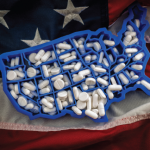The organization is in the early stage of collecting information to build a more complete picture of the financial impact of the crisis on county budgets, Chase says. Indiana County, Pa., a mountainous, predominantly rural region, provides a snapshot of how the crisis is stressing local services and budgets.
Its county seat, the borough of Indiana, is home to a modern college campus and a main street lined by restaurants and American flags. Yet beneath its outward tranquility, the opioid epidemic is everywhere, says David Rostis, an undercover detective and head of the county’s drug task force.
On a recent ride-along in Rostis’ car, he points to a building where a doctor used to sell opioid prescriptions for sex; a large, affluent home where a teenager died of an overdose; a trail where a drug-related killing recently occurred; and the local gas station where a woman recently overdosed and died in her car while people passed by.
In 2016, the county’s drug overdose death rate was 50.6 deaths per 100,000, compared to the state average of 36.5.
Autopsy and toxicology costs there have nearly doubled in six years, from about $89,000 in 2010 to $165,000 in 2016, county data shows.
Court costs are soaring, mainly because of the expense of prosecuting opioid-related crimes and providing accused with a public defender, local officials say.
The county is using contingency funds to pay for the added coroner costs, says Mike Baker, the county’s top government official. Last year, the county drew $63,000 from those funds, up from $19,000 in 2014, he said. In 2014, the county saw 10 drug-related deaths. In 2016, the number had grown to 53.
In Mercer County, W.V., 300 miles (483 km) to the south of Indiana County, opioid-related jail costs are carving into the small annual budget of $12 million for the community of 62,000 people.
The county’s jail expenses are on course to increase by $100,000 this year, compared to 2015. The county pays $48.50 per inmate per day to the jail, and this year the jail is on course to have over 2,000 more “inmate days” compared with 2015, according to county data.
“At least 90% of those extra jail costs are opioid-related,” says Greg Puckett, a county commissioner who sits on a national county opioid task force. “We spend more in one month on our jail bill than we spend per month on economic development, our health department and our emergency services combined.”



